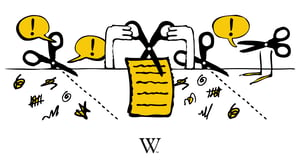Recording
Keep, cut, change: become a brutally effective editor

Readers spend 13 seconds on most emails. And leave webpages after 52 seconds (that means we only have 48 left).
So let’s talk in detail and with supporting examples about the ins-and-outs of editing.
So let's talk about editing.
Step 1: Only keep what your readers need
Look at your rough draft and ask yourself:
- What do my readers need to know?
- What do my readers need to do?
That’s the stuff to keep.
Step 2: Cut repetition, filler phrases and adverbs
Found your knows and dos? Now cut the following:
- Repetition and redundancy are wasteful:
Collaborated together
End result
Contributing factors
Using two or more words that mean the same thing saps your reader’s energy.
- Filler phrases are just as draining. Things like:
As a general rule
The fact of the matter is
Needless to say
We call them ‘throat-clearing’ language. All it does is announce the writer, which isn’t reason enough to add to your word count.
- Adverbs describe an action. They usually end in -ly (quickly, simply, carefully). Cutting them makes your writing concise and confident.
Step 3: Stick to one idea per sentence
An occasional long sentence is a good way to add rhythm to your writing. But shorter sentences guarantee your reader will understand your point. Keep most of yours under 25 words.
Step 4: Write in the active voice
It makes your writing easier to follow.
Passive: The pie was stolen
Active: Jerry stole the pie
Sometimes the passive voice leaves out important information, like who’s doing the action (the subject). That’s information your readers need to know. Putting the subject at the start of your sentence makes things clear.
So that’s how to keep, cut and change a piece of writing as an editor
Repeat steps 1-4 until every part of the message is:
- Called for
- Concise
- Clear